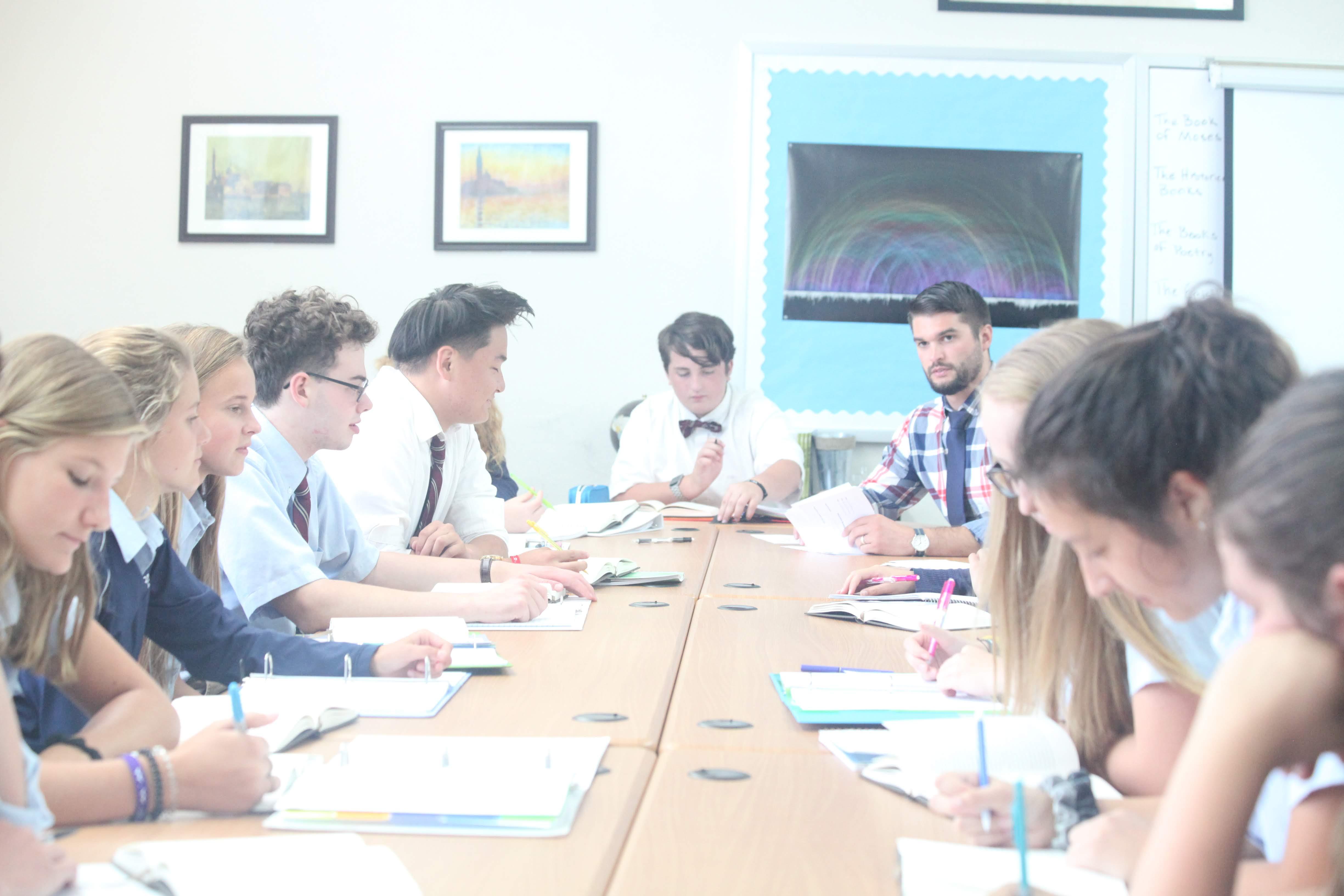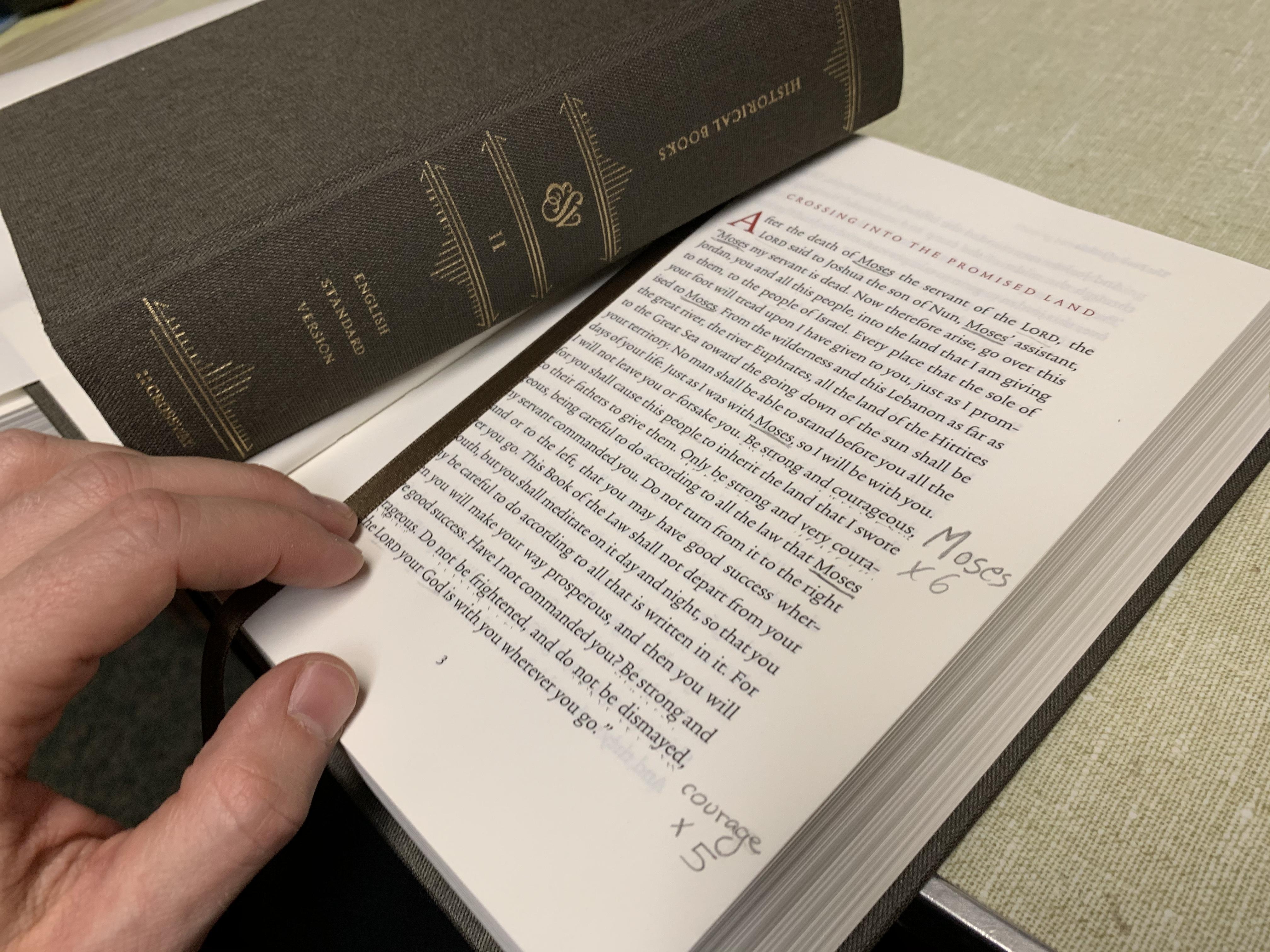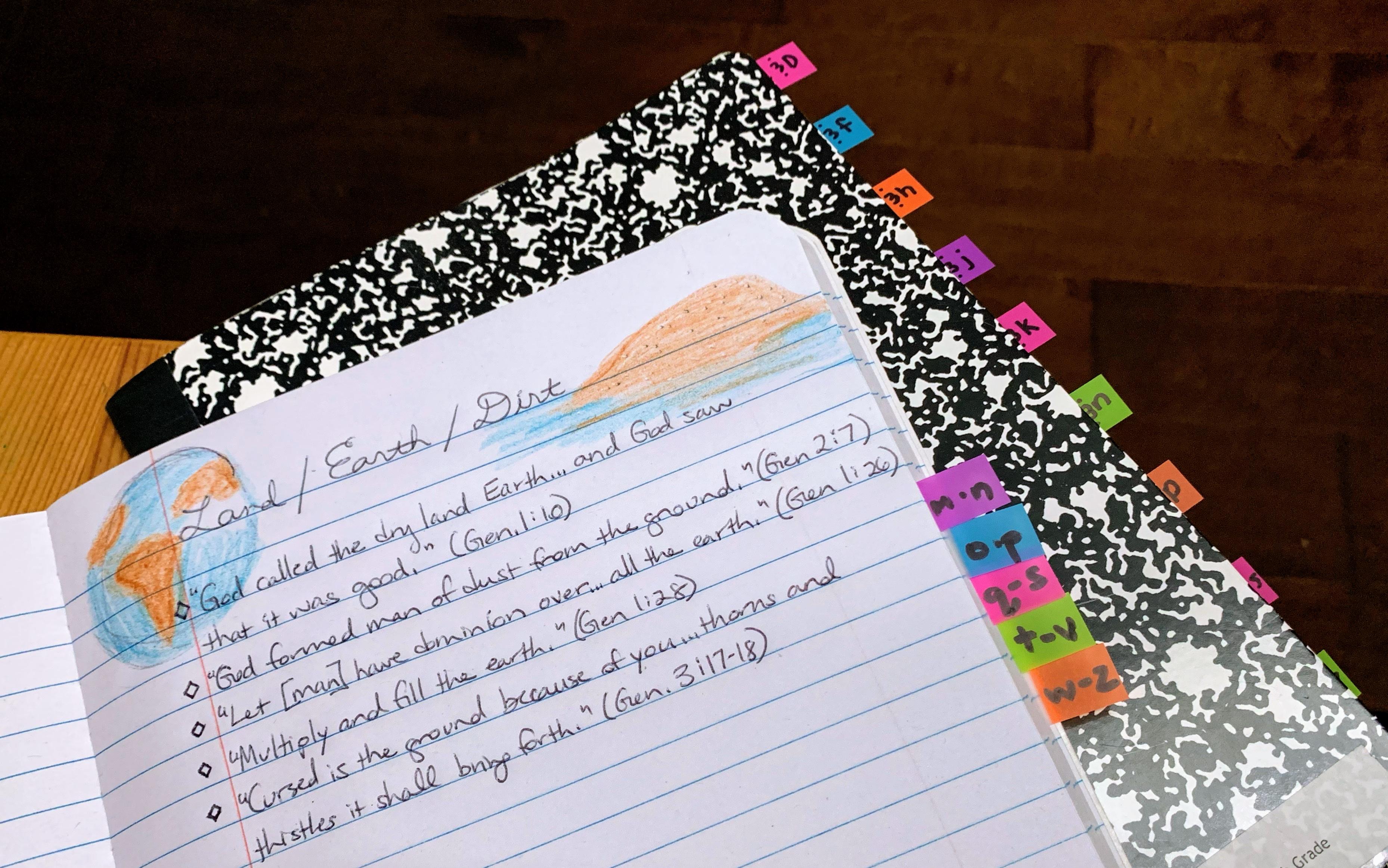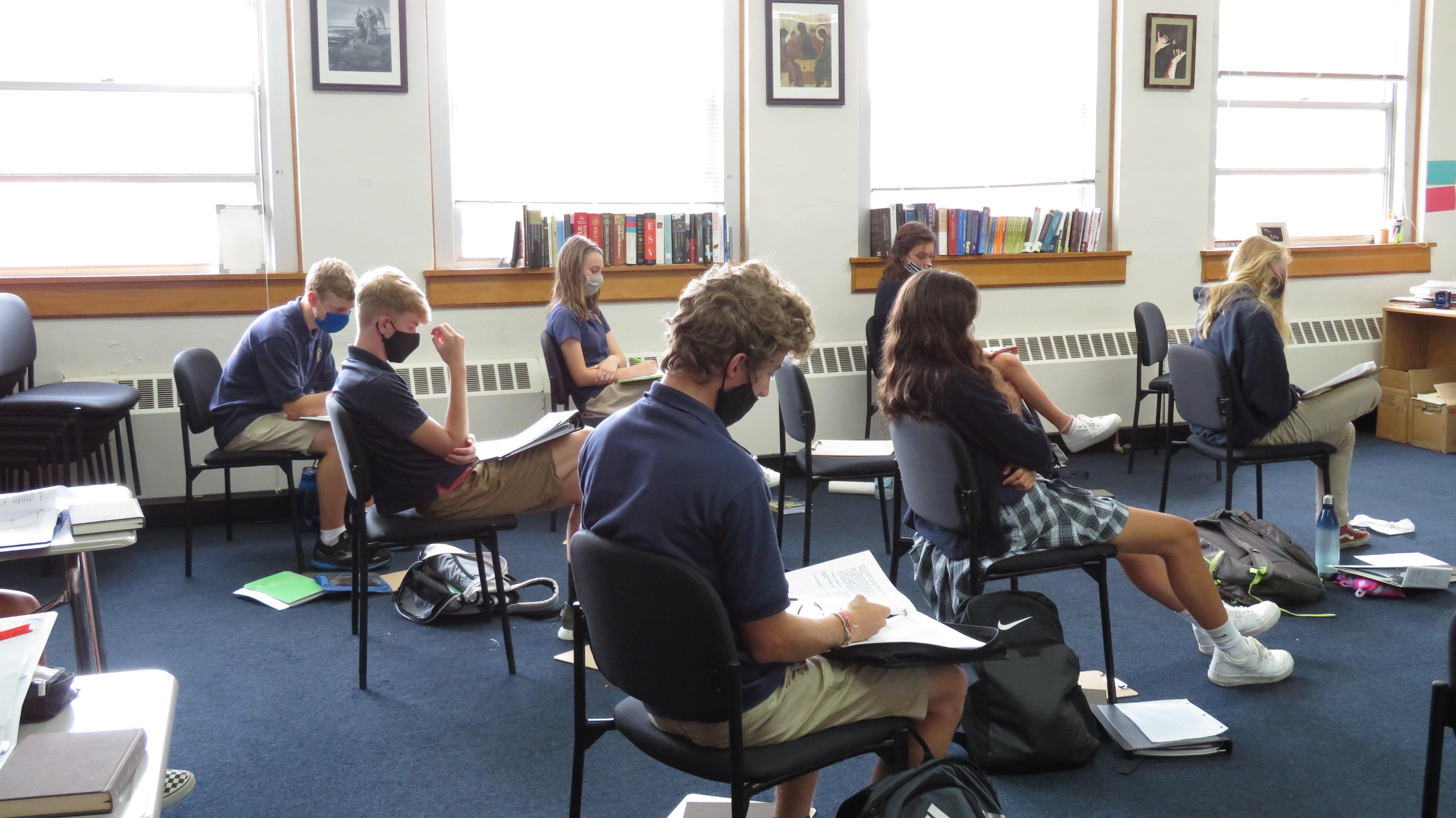At Veritas Christian Academy outside Asheville, NC, the upper school is in its third year of implementing a hands-on literary approach to the Bible. Veritas is a classical school and seeks to apply best practices from teaching other ancient literature in how they study the canon.
Bible at Veritas is a low-tech affair even during COVID with remote learners at home. Class time revolves around hands-on marking of a hard-copy Bible, asking students to apply their existing ELA skills. Students read whole books at a time, reading one section of the canon in each course: Pentateuch, Histories, Poets, Prophets, Gospels-Acts, and Epistles.
Here are six highlights we gathered from conversations with Zach Pritz, Bible department head. We asked: How has your teaching of ancient literature informed your practice in Bible class? How do you cultivate skills in each genre, from history, to poetry, to letter? And how do the ancient genres compare to modern genres—to the skills we already teach in ELA?
1. Cultivate Book Lovers
The scent of Barnes & Noble wafts from Zach’s classroom. Each school year at Veritas begins by opening boxes of ESV reader Bibles that will be the “consumable” textbook for each 6–12th grade course. Students will take their book home at the end of the year, slowly building a personal library of the whole biblical canon. The embossed hardcover on these reader Bibles simply say “Pentateuch” or “Poetry,” but inside, the Bible looks like a novel or set of poems.
Students are taught to treat this book as the valuable resource it is—to mark it, underline, and annotate neatly in pencil. A black-and-white composition book completes the required resources. Students will add quotes to this commonplace book over the six years that they read through the canon. It is a solid setup for a literary approach: A hardcover “novel” plus a growing journal of quotations.
2. Enact a Word-based Liturgy
Poets, writers, and all who savor words love to contemplate or even memorize key quotations. That is one reason that Zach’s liturgy begins with a daily liturgy—a student reading aloud a prayer, a Psalm, or another meditative portion of Scripture. This year Zach is using the Book of Common Prayer together with the whole department so that students can slowly memorize the main portions of Morning Prayer. Quiet prayers arise in the opening moments of class: “We confess that we have sinned against you in thought, word and deed; by what we have done, and by what we have left undone. We have not loved you with our whole heart...”
“The beginning liturgy teaches students reverence for the reading of the biblical text,” Zach said. “Our students rotate as the reader, and their peers stand, learning to respect the public reading of Scripture, which is rooted in church tradition.” This opening liturgy sets a tone for the rest of the class hour.
3. Practice Minimalism
There are so many terrific Christian resources, it can be tempting (and fun) to over utilize a hodge-podge of YouTube videos, book snippets, and curricula. But a danger is that we subtly lean into students’ easily-distracted “browsing” mentality, rather than modeling how to sustain long-term focus on a text. If we jump around between the “many,” we are subtly communicating that black font on a white page is boring. Too boring for sustained attention. Yet, this is what God gave us! Not a video. Not a photo. A text.
To strip away distractions and sustain attention, students are asked to read with a pencil on the text, annotating their way though a full book. But there are two ways to practice sustained attention: 1. Close reading of dense chapters, full of meaning. (Read at least twice.) Or 2. Longer periods of listening to several chapters in one sitting.
“Long form reading teaches the students to follow a plot, poem, or letter from start to finish,” noted Zach. “It also sharpens the students’ attention span by requiring them to work and remain focused. Long form reading isn’t done every class period, because we take time to dive-deep at key moments, but either way, students should interact with the text first-hand prior to the teachers dispensing information.”
Over the years, Veritas teachers have gained skills in teaching ancient narratives. They find that it is best to read in a good translation, to follow-along on a hard-copy as a skilled reader reads relatively swiftly, and then stop and do a close reading at key moments. Since they wouldn’t stop after every paragraph of the Iliad (because it’s lengthy), they keep up a similar pace with much of the Bible’s historical narratives. Otherwise, it can be hard to finish!
Both reading methods seem . . . basic. Does this reduce the role of the teacher or eliminate direct instruction? By no means. But it does mean that the teacher’s role switches from lecture to hands-on coaching in skills. “Students benefit from habits and routines,” Zach explained. “Learning to read Scripture is like apprenticeship. The teacher is the lead learner and should model habits that the students will acquire over time, after much repetition. Good biblical reading should be seen as training.”
4. Embrace English Language Arts
Students at Veritas quickly learn that they will utilize ELA skills daily in Bible class. There is no way to follow a complex text without using tools of genre, structure, precise vocabulary and synonyms. Since ELA is broken into multiple courses in Veritas’ elementary school—to cover phonics, grammar, writing, literature, and Latin—students do enter middle school with solid working-knowledge of genres.
But even if this is not the case, all teachers see it as a win when Bible class reinforces ELA skills. It bridges learning across the curriculum.
Precise attention to language is also how biblical theologians do their work. Many insights found by scholars are missed by average readers only because one’s literary understanding has to be increased to see the connections. Bible study tools that have been discussed for decades (“Listen for repetition”) only work when students understand the range of synonyms for a given word. (More for a future article!)
5. Befriend Ancient History
Since the canon is a collection of texts written in ancient Hebrew and Greek, we need to spend more time entering into the world of ancient history. Zach noted, “Those who authored the biblical text had many similarities to us, but they also saw the world differently and we should learn from their worldview. It requires the reader to take on an ancient imagination.”
But discussing ancient history doesn’t have to be a dry, scholarly affair. In fact, since Veritas’ reader Bibles don’t contain scholarly footnotes or commentary, students have to use class discussion to work out their existing knowledge of ancient cultures and enter into “what this probably meant.”
And don’t underestimate how much ancient knowledge is gained simply through broad reading of the Old Testament. The importance of land, agriculture, fertility, offspring, local gods, and differing gender-social roles is evident directly in Genesis.
Unleash your students’ creativity in wondering what life was like before the modern era! How did the ancient pass on writing, produce needed goods, utilize power, or reason about natural and supernatural forces? Even a bit of ancient background and ancient imagination goes a long way.
6. Unleash a Hunt for Imagery
Recurring words and images create through-lines across the Bible. Teach students to listen for repeated ideas, even if they don’t use the exact same word, and even if they seem like a minor concrete detail. These details will add up to a richer, more beautiful story when we keep track of them. But because motifs lie under the surface, we have to act like detectives. Have you heard repetition and wondered, “Is this a whole-Bible motif?” Check a scholarly work like the Dictionary of Biblical Imagery. Then do some thinking: What would this image mean to ancient people? Where did we see this motif earlier? Does it run all the way from Genesis to Revelation?
“We can be a lead learner, training students as apprentices,” Zach encouraged. “Equip them with skills they need to be those with ‘eyes to see’ and ‘ears to hear’ God’s words, and then let them experience their own journey. My students often see aspects of the biblical text that I haven’t even noticed. I appreciate how we get to journey toward truth together.”
Written by Heidi Dean

Students at Veritas engage in seminar discussion to interpret the text. Zach Pritz sits nearby, ready to coach. (Note: Photo was taken prior to COVID-19)

Reader Bibles use a single column and eliminate headers and numbers.

Students create a notebook of biblical imagery as they see recurring themes and symbols.

Seating is different during COVID, but close reading and seminar discussion remain staples.